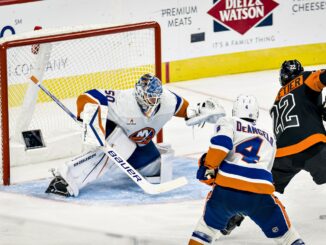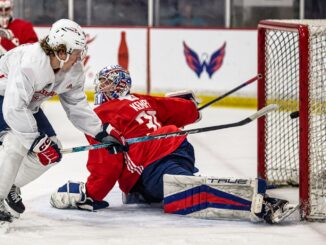The Washington Capitals wrapped up their 2025 Development Camp with five days of spirited drills, high-tempo scrimmages, and off-ice learning sessions at MedStar Capitals Iceplex. For a franchise transitioning from its veteran core to a new era, this year’s camp was more than just a development formality—it was a showcase of serious potential and a culture rooted in accountability, energy, and growth.
From first-round picks experiencing their first taste of pro hockey to returning names pushing to make the leap, the talent on the ice was hard to ignore—and even harder to rank.
A Modern Camp Environment
The structure of Washington’s development camp emphasizes instruction over intensity, with a heavy focus on skating, puck movement, hockey IQ, and position-specific development. Players participated in detailed sessions on gap control, puck retrievals, and small-area battles, while also being exposed to professional lifestyle prep—including cooking classes, leadership workshops, and one-on-one mentoring from former Capitals like Braden Holtby, Logan Thompson, and Olaf Kolzig.
Everything culminated in the high-energy 3-on-3 “Future Caps Cup”—a competitive mini-tournament designed to simulate game pressure and highlight skill in condensed space.
Returning Stars Raise the Bar
The Capitals’ top returning prospects didn’t just show up—they showed out.
Andrew Cristall, fresh off a dominant WHL season, displayed better acceleration, quicker edges, and elite poise with the puck. The play consistently flowed through him during rush drills and scrimmages. His vision, shiftiness, and leadership were all evident, and it’s clear he’ll be a serious contender for NHL minutes by training camp.
Cole Hutson turned in the most complete performance of any defenseman. His skating remains elite, but it was his confidence, vocal presence, and physicality that stood out. He captained Team Red to victory in the 3-on-3 tournament, capped by a bar-down rocket that had the building buzzing. His hockey sense and gap control were dialed in all week.
Ryan Chesley, a steadying presence on the blue line, delivered exactly what you’d expect: defensive reliability, smart outlet passes, and excellent reads. He logged heavy minutes in the scrimmages and scored a clutch goal in the 3-on-3 final. Calm, coachable, and physical—he looks nearly pro-ready.
Terik Parascak built on his strong WHL year with a relentless motor and smart two-way play. Whether it was puck battles, quick forechecks, or clean zone exits, he was consistently noticeable. He also showed great chemistry with Petr Sikora in the tournament, setting up multiple highlight-reel goals.
Petr Sikora, the crafty Czech winger, wowed with soft hands and a deceptive release. He scored several times in the 3-on-3 tournament and proved particularly elusive in tight areas.
Ludwig Persson stood out as one of the most vocal players on the ice. His offensive zone movement and vision gave his line sustained pressure, and he looked increasingly comfortable leading drills and communicating with younger teammates.
Ilya Protas, younger brother of Aliaksei Protas, brought physicality and net-front presence all week. While still raw, he showed notable gains in footwork and puck protection since his last appearance, earning positive feedback for his improved conditioning and attitude.
Cam Allen, a returning right-shot defenseman, was once again one of the loudest voices in the building. He showed more maturity in his reads, better lateral mobility, and continued to bring a heavy, punishing presence in the defensive zone. His open-ice hit on day three drew cheers from teammates and coaches alike.
Fresh Faces Impress
The 2025 draft class made a strong first impression.
Lynden Lakovic, the team’s first-round pick, is a physically imposing winger who flashes NHL potential. His size, shot, and willingness to drive the net were hard to miss. He was raw in skating drills early but adjusted quickly and finished strong—earning his entry-level contract before the camp wrapped.
Milton Gastrin (2nd-rounder) showed off a heavy shot and strong net-front presence. He played a north-south power game and didn’t shy away from contact during board battles.
Maxim Schafer (3rd round) impressed with straight-line speed and long reach. His defensive awareness was ahead of expectations, and he showed promise as a penalty killer.
Jackson Crowder, a skilled center, quietly put together one of the most complete efforts of any rookie forward. His faceoff ability, puck support, and decision-making in transition all earned positive buzz from the staff.
Aron Dahlqvist, a towering Swedish defenseman, brought power and precision. His slapshot popped during point drills, and he displayed a strong stick and smart positioning in 2-on-1 situations. He showed good skating improvements as the week progressed.
Tournament Takeaways & Development Themes
The 3-on-3 “Future Caps Cup” finale was a standout moment of the week. Team Red, led by Hutson and Chesley, edged Team White in a fast-paced, back-and-forth contest. Sikora, Parascak, and Cristall were electric in open ice, while Gastrin and Crowder delivered timely plays to keep things tight.
Across the week, daily skating sessions emphasized acceleration and edge control. Coaches singled out Cristall, Dahlqvist, and Hutson for major improvement. Defensemen were drilled hard on first-pass precision, neutral-zone gaps, and communication—areas where Allen and Chesley thrived.
Goaltenders received elite mentorship from Holtby, Kolzig, and Thompson. They worked on rebound control, breakaway positioning, and game scenario reads. While no single goalie stole the show, coaches noted visible progression throughout the week.
Off the ice, the club doubled down on life development: proper nutrition, time management, and media handling. Several prospects said the program felt “NHL-like” in its expectations—and that was clearly the point.
Culture, Competition, and the Road Ahead
What stood out most wasn’t just the talent—it was the buy-in. Whether it was a returning AHL hopeful like Chesley or a newly drafted 18-year-old like Lakovic, players competed, learned, and supported one another.
Leadership naturally emerged. Hutson commanded drills. Cristall talked younger guys through reps. Chesley modeled professionalism. Parascak, Persson, and Allen added glue. It wasn’t forced—it was a glimpse into what the future locker room might look like.
For an organization facing a transition period, this camp provided a clear message: the pipeline is stocked, and the work is being done.
Final Verdict
If development camp is meant to show the next wave, the Capitals can feel good about where things are headed. The combination of high-end talent (Cristall, Hutson, Lakovic), growing depth (Parascak, Sikora, Gastrin), and promising defense (Chesley, Dahlqvist, Allen) points to a system that’s not just refilling—it’s reloading.
With rookie camp and preseason on the horizon, fans should expect several of these names to make noise in September. Washington isn’t rebuilding from scratch—it’s building something new. And from what we saw this week, the foundation looks rock solid.
CLICK IMAGE FOR FULL GALLERY

























